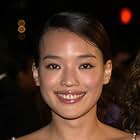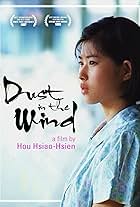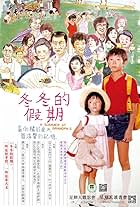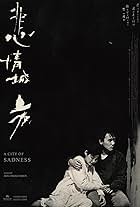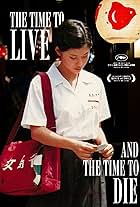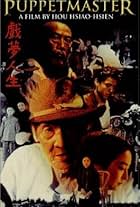IMDb RATING
6.9/10
6.2K
YOUR RATING
Three stories set in three times, 1911, 1966 and 2005. Two actors play the two main characters in each story.Three stories set in three times, 1911, 1966 and 2005. Two actors play the two main characters in each story.Three stories set in three times, 1911, 1966 and 2005. Two actors play the two main characters in each story.
- Awards
- 8 wins & 19 nominations
Lawrence Ko
- (segment "A Time for Love")
- (as Ko Yu-Luen)
- Director
- Writers
- All cast & crew
- Production, box office & more at IMDbPro
Storyline
Did you know
- TriviaThe song Rain and Tears is based on Pachelbel's Canon
- ConnectionsFeatured in Siskel & Ebert: The Best Films of 2006 (2006)
Featured review
Three Times shows Hou Hsiao-Hsien developing further the themes of his two dazzling earlier works Flowers of Shanghai and Millennium Mambo.
It consists of three tales of love and its vicissitudes: A Time for Love, set in 1966, A Time for Freedom set in 1911, and A Time for Youth, set in the present.
As with all great art, everything lies in the style, the tempo, pacing, control of light, the compositions and framing, the control of tone, the nuances of facial expressions and bodily poses and movements, and the way all these amplify and develop the subject.
The incidents depicted are spare and in the case of the first tale almost non existent. Yet through his technique Hou right from the outset creates a mesmerizing, hypnotic, almost overwhelming spell.
This is film making on the grand scale,reminiscent of the great sixties film makers, but almost never seen these days. One wants to invoke the opulence of a Visconti , the deceptively involved and passionate realism of a Godard, the precise formulations of Eric Rohmer and Michelangelo Antonioni.
Beyond film other comparisons come to mind: Raymond Carver's supreme control of tone in elevating the barest of incidents to the stuff of high drama is perfectly matched by Hu, particularly in the first of his tales. The radiant, almost contemplative or prayer-like presentation of the women in all three tales simply reading letters or E-Mails reminds one of nothing so much as Vermeer.
In each part the style perfectly matches the themes - restraint (whether tentative and hesitant, or formalized and implacable) in the first two, and gorgeous excess in the last.
And in each section there is a succession of moments so beautiful, so "right" and so new, one really wants to shout it from the rooftops.
Whilst Three Times perhaps lacks the cumulative dramatic power of the two earlier films, it shares with them the exhilaration one gets from knowing one is viewing a great artist at the peak of his powers, the sense that he can literally do anything he wants, that no subject is beyond him.
If you haven't seen these films do yourself a favor and seek them out - they are quite possibly among the most important art of our time.
It consists of three tales of love and its vicissitudes: A Time for Love, set in 1966, A Time for Freedom set in 1911, and A Time for Youth, set in the present.
As with all great art, everything lies in the style, the tempo, pacing, control of light, the compositions and framing, the control of tone, the nuances of facial expressions and bodily poses and movements, and the way all these amplify and develop the subject.
The incidents depicted are spare and in the case of the first tale almost non existent. Yet through his technique Hou right from the outset creates a mesmerizing, hypnotic, almost overwhelming spell.
This is film making on the grand scale,reminiscent of the great sixties film makers, but almost never seen these days. One wants to invoke the opulence of a Visconti , the deceptively involved and passionate realism of a Godard, the precise formulations of Eric Rohmer and Michelangelo Antonioni.
Beyond film other comparisons come to mind: Raymond Carver's supreme control of tone in elevating the barest of incidents to the stuff of high drama is perfectly matched by Hu, particularly in the first of his tales. The radiant, almost contemplative or prayer-like presentation of the women in all three tales simply reading letters or E-Mails reminds one of nothing so much as Vermeer.
In each part the style perfectly matches the themes - restraint (whether tentative and hesitant, or formalized and implacable) in the first two, and gorgeous excess in the last.
And in each section there is a succession of moments so beautiful, so "right" and so new, one really wants to shout it from the rooftops.
Whilst Three Times perhaps lacks the cumulative dramatic power of the two earlier films, it shares with them the exhilaration one gets from knowing one is viewing a great artist at the peak of his powers, the sense that he can literally do anything he wants, that no subject is beyond him.
If you haven't seen these films do yourself a favor and seek them out - they are quite possibly among the most important art of our time.
- How long is Three Times?Powered by Alexa
Details
Box office
- Gross US & Canada
- $151,922
- Opening weekend US & Canada
- $14,197
- Apr 30, 2006
- Gross worldwide
- $581,875
- Runtime2 hours
- Color
- Sound mix
- Aspect ratio
- 1.85 : 1
Contribute to this page
Suggest an edit or add missing content










